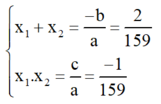Giải phương trình 4x2-12x+9=x+7
Hãy nhập câu hỏi của bạn vào đây, nếu là tài khoản VIP, bạn sẽ được ưu tiên trả lời.


1.\(\left(x+2\right)\left(2x-3\right)=x^2-4\)
\(\Leftrightarrow\left(x+2\right)\left(2x-3\right)-\left(x+2\right)\left(x-2\right)=0\)
\(\Leftrightarrow\left(x+2\right)\left(2x-3-x+2\right)=0\)
\(\Leftrightarrow\left(x+2\right)\left(x-1\right)=0\)
\(\Leftrightarrow\left[{}\begin{matrix}x=-2\\x=1\end{matrix}\right.\)
2.\(x^2+3x+2=0\)
\(\Leftrightarrow x^2+x+2x+2=0\)
\(\Leftrightarrow x\left(x+1\right)+2\left(x+1\right)=0\)
\(\Leftrightarrow\left(x+1\right)\left(x+2\right)=0\)
\(\Leftrightarrow\left[{}\begin{matrix}x=-1\\x=-2\end{matrix}\right.\)
3.\(2x^2+5x+3=0\)
\(\Leftrightarrow2x^2+2x+3x+3=0\)
\(\Leftrightarrow2x\left(x+1\right)+3\left(x+1\right)=0\)
\(\Leftrightarrow\left(x+1\right)\left(2x+3\right)=0\)
\(\Leftrightarrow\left[{}\begin{matrix}x=-1\\x=-\dfrac{3}{2}\end{matrix}\right.\)
4.\(x^3+x^2-12x=0\)
\(\Leftrightarrow x\left(x^2+x-12\right)=0\)
\(\Leftrightarrow x\left(x+4\right)\left(x-3\right)=0\)
\(\Leftrightarrow\left[{}\begin{matrix}x=0\\x=-4\\x=3\end{matrix}\right.\)
a: \(\Leftrightarrow\left(x+2\right)\left(2x-3\right)-\left(x+2\right)\left(x-2\right)=0\)
\(\Leftrightarrow\left(x+2\right)\left(2x-3-x+2\right)=0\)
=>(x+2)(x-1)=0
=>x=-2 hoặc x=1
b: =>(x+1)(x+2)=0
=>x=-1 hoặc x=-2
c: =>(2x+3)(x+1)=0
=>x=-1 hoặc x=-3/2
d: =>x(x+4)(x-3)=0
hay \(x\in\left\{0;-4;3\right\}\)

a) Phương trình 4 x 2 + 2 x − 5 = 0
Có a = 4; b = 2; c = -5, a.c < 0
⇒ Phương trình có hai nghiệm x 1 ; x 2
Theo hệ thức Vi-et ta có: 
b) Phương trình . 9 x 2 − 12 x + 4 = 0
Có a = 9; b' = -6; c = 4 ⇒ Δ 2 = ( - 6 ) 2 - 4 . 9 = 0
⇒ Phương trình có nghiệm kép x 1 = x 2 .
Theo hệ thức Vi-et ta có: 
c) Phương trình 5 x 2 + x + 2 = 0
Có a = 5; b = 1; c = 2 ⇒ Δ = 1 2 − 4.2.5 = − 39 < 0
⇒ Phương trình vô nghiệm.
d) Phương trình 159 x 2 − 2 x − 1 = 0
Có a = 159; b = -2; c = -1; a.c < 0
⇒ Phương trình có hai nghiệm phân biệt x 1 ; x 2 .
Theo hệ thức Vi-et ta có: 

b: \(\Leftrightarrow\left|2x-3\right|=7\)
\(\Leftrightarrow\left[{}\begin{matrix}2x-3=7\\2x-3=-7\end{matrix}\right.\Leftrightarrow\left[{}\begin{matrix}x=5\\x=-2\end{matrix}\right.\)
\(a,ĐK:x\ge0\\ PT\Leftrightarrow4\sqrt{x}-2\sqrt{x}+3\sqrt{x}=12\\ \Leftrightarrow5\sqrt{x}=12\Leftrightarrow\sqrt{x}=\dfrac{12}{5}\\ \Leftrightarrow x=\dfrac{144}{25}\left(tm\right)\\ b,PT\Leftrightarrow\sqrt{\left(2x-3\right)^2}=7\Leftrightarrow\left|2x-3\right|=7\\ \Leftrightarrow\left[{}\begin{matrix}2x-3=7\\3-2x=7\end{matrix}\right.\Leftrightarrow\left[{}\begin{matrix}x=5\\x=-2\end{matrix}\right.\)

13 x - 3 2 x + 7 + 1 2 x + 7 = 6 x 2 - 9 Đ K X Đ : x ≠ ± 3 v à x ≠ - 7 2 ⇔ 13 x + 3 x 2 - 9 2 x + 7 + x 2 - 9 2 x + 7 x 2 - 9 = 6 2 x + 7 x 2 - 9 2 x + 7
⇔ 13(x + 3) + x 2 – 9 = 6(2x + 7)
⇔ 13x + 39 + x 2 – 9 = 12x + 42
⇔ x 2 + x – 12 = 0
⇔ x 2 – 3x + 4x – 12 = 0
⇔ x(x – 3) + 4(x – 3) = 0
⇔ (x + 4)(x – 3) = 0
⇔ x + 4 = 0 hoặc x – 3 = 0
x + 4 = 0 ⇔ x = -4 (thỏa mãn)
x – 3 = 0 ⇔ x = 3 (loại)
Vậy phương trình có nghiệm x = -4.

`a)x^2>4`
`<=>sqrtx^2>sqrt4`
`<=>|x|>2`
`<=>` \(\left[ \begin{array}{l}x>2\\x<-2\end{array} \right.\)
`b)x^2<9`
`<=>\sqrtx^2<sqrt9`
`<=>|x|<3`
`<=>-3<x<3`
`c)(x-1)^2>=4`
`<=>\sqrt{(x-1)^2}>=sqrt4`
`<=>|x-1|>=2`
`<=>` \(\left[ \begin{array}{l}x-1 \ge 2\\x-1 \le -2\end{array} \right.\)
`<=>` \(\left[ \begin{array}{l}x \ge 3\\x \le -1\end{array} \right.\)
`d)(1-2x)^2<=0,09`
`<=>\sqrt{(1-2x)^2}<=sqrt{0,09}`
`<=>|2x-1|<=0,3`
`<=>-0,3<=2x-1<=0,3`
`<=>0,7<=2x<=1,3`
`<=>0,35<=x<=0,65`
`e)x^2+6x-7>0`
`<=>x^2-x+7x-7>0`
`<=>x(x-1)+7(x-1)>0`
`<=>(x-1)(x+7)>0`
TH1:
\(\left[ \begin{array}{l}x-1>0\\x+7>0\end{array} \right.\)
`<=>` \(\left[ \begin{array}{l}x>1\\x>-7\end{array} \right.\)
`<=>x>1`
TH2"
\(\left[ \begin{array}{l}x-1<0\\x+7<0\end{array} \right.\)
`<=>` \(\left[ \begin{array}{l}x<1\\x<-7\end{array} \right.\)
`<=>x<-7`
`f)x^2-x<2`
`<=>x^2-x-2<0`
`<=>x^2-2x+x-2<0`
`<=>x(x-2)+x-2<0`
`<=>(x-2)(x+1)<0`
`<=>` \(\begin{cases}x-2<0\\x+1>0\\\end{cases}\)
`<=>` \(\begin{cases}x<2\\x>-1\\\end{cases}\)
`<=>-1<x<2`
a) x2 > 4
<=> \(\left[{}\begin{matrix}x>2\\x< -2\end{matrix}\right.\)
b) \(x^2< 9\)
<=> \(-3< x< 3\)
c) \(\left(x-1\right)^2\ge4\)
<=> \(\left[{}\begin{matrix}x-1\ge2< =>x\ge3\\x-1\le-2< =>x\le-1\end{matrix}\right.\)
d) \(\left(1-2x\right)^2\le0,09\)
<=> \(-0,3\le1-2x\le0,3\)
<=> \(1,3\ge2x\ge0,7\)
<=> \(0,65\ge x\ge0,35\)
e) \(x^2+6x-7>0\)
<=> \(\left(x+7\right)\left(x-1\right)>0\)
<=> \(\left[{}\begin{matrix}x-1>0< =>x>1\\x+7< 0< =>x< -7\end{matrix}\right.\)
f) \(x^2-x< 2\)
<=> \(x^2-x-2< 0\)
<=> \(\left(x-2\right)\left(x+1\right)< 0\)
<=> \(\left\{{}\begin{matrix}x+1>0< =>x>-1\\x-2< 0< =>x< 2\end{matrix}\right.\)
<=> -1 < x < 2
g) \(4x^2-12x\le\dfrac{-135}{16}\)
<=> \(64x^2-192x+135\le0\)
<=> (8x - 15)(8x - 9) \(\le0\)
<=> \(\left\{{}\begin{matrix}8x-15\le0< =>x\le\dfrac{15}{8}\\8x-9\ge0< =>x\ge\dfrac{9}{8}\end{matrix}\right.\)
<=> \(\dfrac{9}{8}\le x\le\dfrac{15}{8}\)


\(4\cdot2-12x+9=x+7\)
\(\Leftrightarrow8-12x+9=x+7\)
\(\Leftrightarrow-12x-x=7-8-9\)
\(\Leftrightarrow-13x=-10\)
\(\Leftrightarrow x=\dfrac{10}{13}\)
Vậy \(x=\dfrac{10}{13}\)